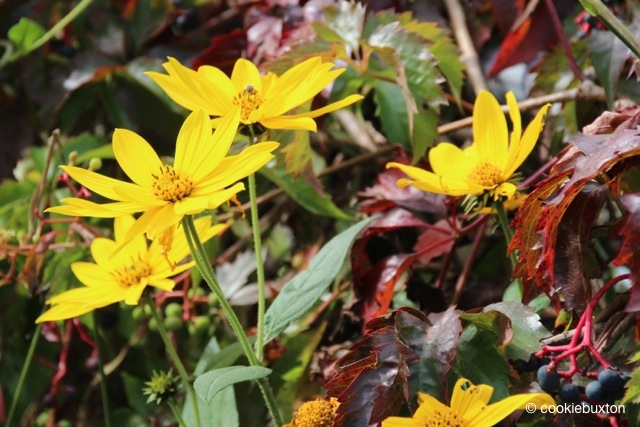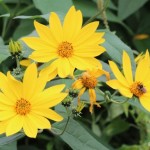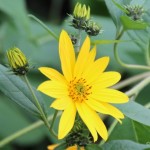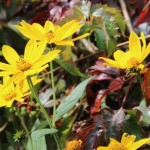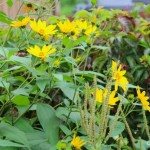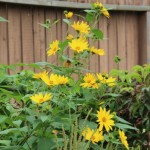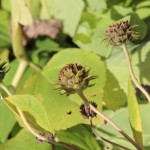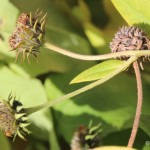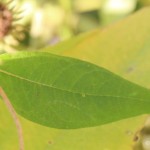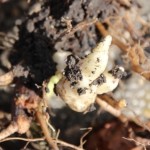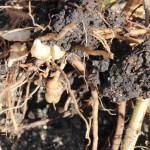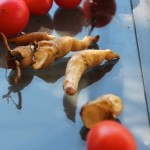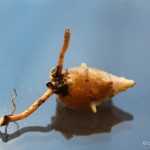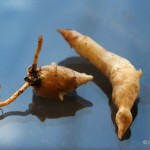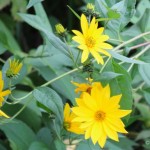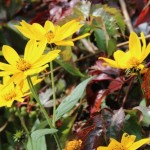Jerusalem Artichoke
Jerusalem Artichoke (Helianthus tuberosus) is a tall, native North American sunflower that blooms in August and September in the zone 3 prairie region. As a perennial, it adds colour and interest to the fall garden.
There are several accounts of the naming of Jerusalem arthichoke; it seems most likely to have arisen from a bad translation of the early Italian name for the plant, “Girasole articiocco,” or sunflower artichoke. In the southern United States in the 1960s, the term “sunchoke” was coined to avoid confusion in referring to a plant that has no geographical relation to Jerusalem and is not an artichoke. I find the translated name amusing, and rather like the history behind the badly named plant, and so am calling it by its common local name still in use in my province, which is Jerusalem Artichoke.
Jerusalem Artichoke made its way over from North America to Europe via early travellers in the early 1600s, in the days of Samuel de Champlain’s explorations. It has been grown in Europe since that time both as a decorative fall plant and as a food product used in making liqour. In Germany and France, Jerusalem artichokes have been harvested to produce Jerusalem artichoke brandy, which is described as having an earthy, nutty-sweet flavour. The Italians use it as well for the liquor cabinet as flavouring for a light aperitif.
While of on-going interest for its culinary possibilities, and the subject of rather extensive research, the plant has a reputation when eaten for causing serious gas and upset stomach issues for many folks. Here is a rather interesting quote by English botanist John Goodyer, who helped to revise (1633) Gerard’s Herbal. I have combined two sources to reconstruct this quote, and hope I am presenting it correctly for you: “Jerusalem artichokes…are dressed divers wayes, some boile them in water…others bake them in pies…others some other way as they are led by their skill in Cookerie,” wrote Mr. Goodyer. “But in my judgment, which way soever they be drest and eaten they stirre and cause a filthie loathesome stinking winde within the bodie, thereby causing the belly to be much pained and tormented, and are a meat more fit for swine than men.”
Without casting any aspersions whatsoever on swine, pigs evidently can eat the tubers without discomfort.
Still, the plant has properties that are valued.
Some of us, and I am in this group, simply like to have tall, bright yellow flowers to enliven a corner of the garden in late summer, when other flowers have finished their showy displays for the season. Despite its tendency to wander, I keep this plant for two reasons: one, I rather like it; and two, it is difficult to eradicate. It spreads by tuberous rhizomes under my side fence and back fence and creeps into my neighbour’s yard. But we are old friends, and my neighbour simply yanks the stalks out of her vegetable garden each spring with a small groan, as she knows I enjoy the bright yellow flowers each fall.
As a flower, it is neither significantly handsome nor particularly stately. It grows generously upwards of two metres (above six feet) in height in my prairie zone 3 climate, and, without support, will lean or flop in a heavy wind or rainstorm. It misbehaves, and spreads its tuberous roots underground. In an agricultural setting, it can become a serious nuisance to farmers if it escapes into a crop of corn or soy or wheat.
In an urban garden, it can be fairly easily confined. I let it grow along the back fence, and I noticed this year it spread into the back lane, competing for space with my daylilies and lily of the valley. It is easy, in the small amount of territory it has, to keep Jerusalem artichoke under reasonable control. It can be pulled out with a quick yank on the young stalk, and its seasonal life can be ended easily in that fashion. It will, though, show up again the next year as the remains of the tubers send up new shoots.
Many chefs and home cooks have found solutions to its gas-producing qualities and cook the tubers for their light, nutty flavour in “diverse ways.” There are many interesting recipes and cooking techniques posted online.
The complex molecules produced by this plant, inulin polysaccaride, are touted as being useful as a dietary sweetener suitable for diabetes.
According to research conducted at the Morden Research Centre in Manitoba and elsewhere, the plant has strong potential as a feedstock for producing ethyl alcohol, a biomass fuel alternative to traditional fuel resources. Projections are for an ethanol yield per acre of up to four times that of sugar beets, corn, or wheat.
To learn more about the plant from a farming perspective, you may wish to review the Ontario government’s useful information sheet:
www.omafra.gov.on.ca/english/crops/facts/94-077.htm
There is an abundance of online recipes describing how to prepare and cook Jerusalem Artichoke tubers as a specialty food product, with suggestions on introducing the item slowly and carefully into the diet while monitoring for the “winde” effect.
To simply grow Jerusalem Artichoke as a flower, remember to keep it under good regulation, and enjoy the little bit of sunshine that the sunflower artichoke, Helianthus tuberosus, brings in fall when summer plants are past their days of glory.
Copy and photographs: copyright N. Kampen / Cookie Buxton
Photograph location: NK home garden
Photo Gallery
Click on any image to enlarge; click on the enlarged photograph to advance through the photograph series.
